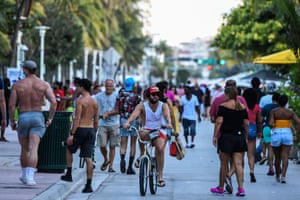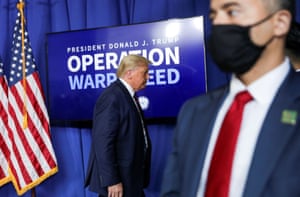The US has crossed the threshold of 150,000 confirmed deaths from Covid-19, just six months after the first cases were diagnosed in China and with the outbreak far from under control.
The American death toll is the highest in the world by a significant margin and reached 150,034 on Wednesday, according to the Johns Hopkins University world coronavirus tracker.
More than 4.3 million people have been infected with Covid-19, the disease caused by the novel coronavirus Sars-CoV-2. As the summer has worn on, outbreaks have spread across America’s sun belt, the region from Florida to southern California, and look increasingly likely to spread into central states. Meanwhile, some early centers of the pandemic, such as New York City, have brought the virus under significantly more control.
The pandemic has rewritten nearly every aspect of daily life in the United States. Economic activity depressed by public health restrictions and virus outbreaks brought the jobless rate above 11% in June. Restaurant, museum and cinema closures are rolling as states try to reopen, see outbreaks, and again restrict activities.

Schools, once thought certain to reopen in the fall, are grappling with how to make buildings safe for teachers and students. This week, the nation’s second-largest teachers union authorized local strikes as a “last resort” bargaining chip when districts fail to put coronavirus safety measures in place.
Meanwhile, many of the measures most fundamental to bringing the virus under control have continued to be challenges thanks to a fumbling and anemic federal response, led by the Trump administration.
Widespread outbreaks and week-long delays in test results have undermined contact tracing. Those fundamental failures have had knock-on effects, as outbreaks have reached nursing homes and continued to fill intensive care units with the most vulnerable, ill and resource-intensive patients.
As the coronavirus spread accelerated in March, and without federal leadership, state governors and hospitals began scrambling for ventilators and personal protective equipment such as masks, gloves and gowns for frontline medical workers, who were in many places short of supplies and who themselves began dying from Covid-19.
The politics of a pandemic
Politics has taken a central role in how the pandemic has been tackled. The president initially downplayed the virus and predicted it would disappear – then, despite the US becoming the world’s pandemic hotspot, he urged businesses and now schools to reopen before the sustained decline in cases that federal health experts recommend.
Some mitigation methods, such as widespread use of face coverings in public, have been undermined by the president, who only recently supported their use.
The president’s controversial shunning of mask-wearing and promotion of dubious treatments for the virus has also publicly set him against his own health specialists, including Dr Anthony Fauci, who has been the nation’s top infectious disease expert to six presidents.

Trump has touted the restrictions he placed on travel to the US from China and then parts of Europe as evidence his administration has handled the outbreak well, despite the limited effect those measures have had as the virus spread.
The surge of infections followed a rush to reopen for business in many states, without accompanying mandates or even official recommendations to wear face masks and practice social distancing.
States such as Florida have kept their economies open despite full hospitals, but there are signs the strategy will not be enough to bring the economy back to the record highs of pre-pandemic days. Last week, for the first time in months, there was an increase in the number of people claiming unemployment benefits.
Public health experts are also concerned about the levels of infection in states such as Ohio, Indiana, Tennessee and Kentucky, while the surge in Florida along with Texas, Arizona and California in June and July has strained many hospitals.
Coronavirus has had a hugely disproportionate impact on Black, Latino and Native Americans, significantly exacerbated by racial disparities in chronic health conditions, access to affordable and quality doctors and hospitals, and disparities in income, housing and risk of exposure in the workplace.
A global push is on to develop a vaccine and the US has some promising trials under way, even as public health officials anticipate any plan to equitably distribute a potential vaccine will face blowback.
In the meantime, the most senior federal health officials, such as Fauci and the director of the US Centers for Disease Control and Prevention, Dr Robert Redfield, have warned the outbreak in the US is far from under control, has a “disturbing” trajectory and has brought America “to its knees”.
All of this has put pressure on Congress to pass another coronavirus aid package, one that includes funding for schools, unemployment benefits and hunger relief. But as of now, there is still a gulf between the parties, with Republicans proposing to cut expanded unemployment aid to $200 per week. Meanwhile, with a gap in aid, observers are predicting a wave of evictions could come to pass.
The Link LonkJuly 30, 2020 at 03:04AM
https://www.theguardian.com/us-news/2020/jul/29/covid-19-coronavirus-150000-us-deaths
US passes 150,000 coronavirus deaths amid fresh surge in cases - The Guardian
https://news.google.com/search?q=fresh&hl=en-US&gl=US&ceid=US:en

No comments:
Post a Comment